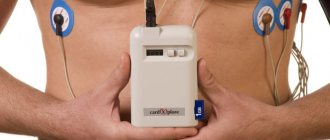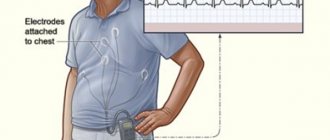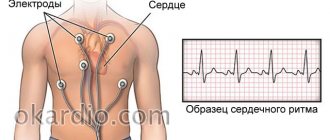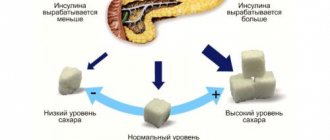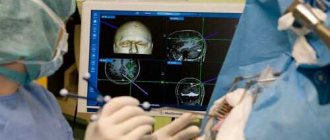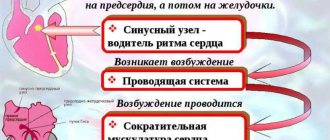Holter is a medical device for recording an electrocardiogram throughout the day. This device is named after the English inventor Norman Jeffers Holter, who first used this device in 1961. This name of the device is more often used in everyday life, and its scientific name is 24-hour Holter electrocardiogram monitor.
Why do you need a holter?
The human heart is a complex muscular organ, the functioning of which can malfunction, which can be fatal. Often, problems in the functioning of the heart can arise only in certain conditions, and their identification is difficult during a routine visit to a cardiologist and recording an ECG at the appointment. After all, during the usual procedure for recording an ECG, from 3 to 20 cycles of heartbeats are recorded, and there are at least hundreds of thousands of them per day! That is, in simple terms, the doctor may not “catch” a pathological episode of heart rhythm on the tape.
Holter studies - what is it?
The essence of diagnosis is the continuous recording of heartbeat rhythms. To do this, electrode sensors are fixed on the patient's chest, transmitting the converted information to a cardiac recorder (holter) - a small device for recording an ECG that can be worn on a belt. Thus, a person may not change his usual way of life when a portable ECG device conducts constant cardiac monitoring. As a rule, observation is carried out within 24 hours, but if there are indications, the procedure can be prescribed for up to 7 days.
The weight of the equipment usually does not exceed 500 g, so it does not require changes in the usual daily routine. The examination is possible for both adults and children.
When is Holter use necessary?
- If there are complaints about disruptions in the functioning of the heart: pain, loss of consciousness, unprovoked rhythm disturbance, etc.;
- For heart defects;
- Preventive and/or diagnostic observation of patients with diagnosed ischemic heart disease, arrhythmias;
- Patients with hypertension, especially if the diagnosis of arterial hypertension is established for the first time, or when the effectiveness of prescribed therapy decreases;
- People with diseases of the endocrine system;
- A patient who is overweight;
- With repeated episodes of loss of consciousness;
- Weather-dependent people;
- To evaluate the performance of the pacemaker;
- To assess the effectiveness of the treatment
Decoding the results
To decrypt the data, the Holter is connected to a computer, after which a specialist analyzes it. The list of observation results includes the following indicators:
- the total time of fixation of contractions, indication of the frequency of beats;
- conduction disturbance (blockade);
- pauses in activity;
- rhythmic disruptions;
- assessment of the dynamics of individual ECG segments;
- other information important for making a diagnosis.
Monitoring allows you to identify any deviations in the functioning of the cardiovascular system and prescribe adequate therapy to restore its normal activity.
How is monitoring carried out?
To carry out daily ECG monitoring, you will need to make 2 visits to the doctor: during the first visit, a portable recorder is installed: disposable adhesive electrodes are fixed to the chest area, and a bag with a recorder is fixed on your belt. Modern devices are compact and quite light (about half a kilogram). At the follow-up appointment, the monitor is removed, the data is entered into a special program and analyzed by a cardiologist.
ECG monitoring with a Holter device is usually prescribed for 24 hours; in certain cases, the diagnostic time can be extended to 48-72 hours or even a week.
No special preparation is required for Holter installation; in rare cases, it is necessary to remove hair in the area where the electrodes are installed.
During the study, a person should live his normal life, with the exception of active physical activity and water treatments, as well as strong temperature changes (this can damage the device). Sometimes the subject may be given special instructions, such as keeping a diary of activity and rest, taking medications, episodes of anxiety, etc. Also, the doctor may ask the patient to perform certain physical exercises: climbing or descending stairs, running - for the most accurate assessment of the work of the heart muscle in various conditions.
During Holter monitoring, it is not recommended to be near powerful electrical equipment, transformer boxes, etc.
Holter: monitoring and analysis of heart function
A holter is attached to the patient, most often on a belt, in a special case and electrodes are applied. Doctors often use the phrase “hang up the Holter” or “make a Holter”, meaning that the device will be used for 24 hours, on an outpatient basis, in the patient’s usual living conditions - at home, at work, during night sleep. Patients are asked not to wet the device, but otherwise lead their usual lifestyle.
This process of taking readings is called Holter monitoring, named after the American research scientist Norman J. Holter, who first used this technique in 1961.
What measurements does Holter take?
- Electrocardiogram recording;
- Determination of heart rate, including the maximum and minimum number of heart rates per minute, as well as the average heart rate;
- Recording physical activity and rest (actiography);
- Blood pressure measurement (modern Holter recorders allow ABPM to be carried out simultaneously with a study of cardiac activity.
You can sign up for Holter monitoring in our clinic right now, and receive a detailed report within 24 hours!
Types of blood pressure monitoring
There are two ways to monitor your heart:
- Full-scale monitoring - ABPM Holter - a continuous 3-day study, as a result of which various pathologies are identified, including their early stages. More than 100 thousand heart beats are recorded, blood pressure readings are recorded;
- Fragmentary monitoring of cardiac activity - an electrocardiogram (ECG) - is capable of recording a negligible fraction of heart beats, about 50. Accordingly, the general idea of the presence of a potential health problem is not fully objective and relevant at the current time. This study is prescribed for patients who do not experience regular pain in the heart area.
Holter ABPM is a study that is indicated for patients who suffer from constant pain in the sternum from the heart, tingling or pinching, and a feeling of cardiac discomfort.
It's easy to go through the research.
It is easy to undergo a study at the Poema Health clinic. It is located near Ozerki metro station and Prosveshcheniya metro station, the halter is installed quickly and at a time convenient for you. The best version of the device will be selected, instructions will be provided and the device will be installed. Upon completion of the study, you will return to us, and the doctor will decipher the data from the Holter and, comparing it with your diary, will make a diagnosis. After this, you can decide on treatment and be firmly on the path to recovery.
Have questions? Call: +7(812) 30-888-03.
What to avoid during Holter diagnostics
The use of a holter has its own characteristics. The Holter ECG result can be disrupted by a number of devices. This will make the results incorrect and undo all the work.
- You must not use the microwave oven or even approach it while it is operating.
- Devices that transmit radio signals cannot be used; mobile phones can be used without restrictions
- You should avoid the metal detector frame; it is not even recommended to walk near it
- You cannot pass through the electromagnetic arches that the stores are equipped with. It is better to avoid shopping altogether on the day of diagnosis.
- You cannot go through other diagnostic options using x-rays, ultrasound, magnetic waves
- Do not remove batteries from the recorder, expose it to intense heat, or get it wet.
Is it possible to deceive smad
Distortion of the results of daily blood pressure monitoring is necessary primarily for conscripts who are suspected of having hypertension. To ensure that the smad procedure displays the result distorted, you can try the following actions during the day:
- While fixing the cuff on the arm, the specialist should hold your breath until it is filled with oxygen;
- When measuring blood pressure, try tensing your leg muscles and gradually tightening your limbs. This increases the displayed pressure slightly;
- a few days before the procedure, you can start taking tinctures of tonic drugs;
- while wearing ABPM you should take energy drinks, strong coffee, tea, caffeine;
- To increase your daily average, you need to try not to sleep during the event.
Holter examination will not cause any inconvenience
If you need a Holter ECG, but you are afraid of the procedure itself, then you just need to understand the rules for its implementation. The doctor will place electrodes on your body, mainly on the bones of the chest with minimal muscle coverage. The natural movement of muscles during movement and breathing can reduce the accuracy of data recording. The electrodes do not generate electric shock and do not produce any effect on your body at all. After installing the electrodes, the recorder is turned on and the study begins. That's all it takes.
What you should know about 24-hour Holter monitoring
Note Lakhta Clinics. We do not know from whose difficult hand, instead of the long-established and intuitively understandable term “monitoring” (from the English.
“observation, control”) in relation to Norman Holter’s technique, such an awkward and cumbersome word “monitoring” appeared in the Russian language.
In this material, we adhere to common sense and translate the name of the method as it is written and sounded in the original: monitoring.
What is Holter monitoring?
A portable, battery-powered, self-contained electrocardiograph is used, which is attached to the body and records the main indicators of heart function during a person’s daily activities.
When a patient comes to an appointment with complaints of heart problems, the doctor usually suggests an ECG (electrocardiography) to clarify the diagnosis. A standard stationary electrocardiograph provides a “snapshot” of the overall electrical activity of the heart.
If such a snapshot is not informative enough, daily Holter monitoring is prescribed.
The technology is almost the same as with a standard ECG: thin wires extend from a compact device mounted on the body, which are connected through electrodes to several points on the chest.
Depending on the nature of the symptoms present and the approximate frequency of their occurrence, the doctor may prescribe Holter monitoring for 12, 24 or 48 hours.
The most common indications for monitoring:
- fast or slow heart rate;
- dizziness (including when using a pacemaker);
- weakness and/or fatigue;
- feeling of lack of air;
- chest pain;
- feeling of “fluttering heart”;
- interruptions, uneven heartbeat;
- feeling of “missed heartbeats”.
Many heart problems occur sporadically throughout the day, and it is very unlikely that a person would end up in a doctor's office at that time.
This is one of the most important advantages of Holter monitoring: the device will register pathological abnormalities whenever they occur, which will allow us to establish the root cause of such disorders.
In addition, the Holter device allows you to monitor the condition of a person with already diagnosed cardiovascular disease. Most people feel much more comfortable with such a discreet device, preferring it to a long hospital stay.
Finally, the doctor may order 24-hour Holter monitoring to assess the effectiveness of the patient's medications.
How to use it
The Holter monitor is very easy to use, even if out of habit the technique looks complicated. The recorder is small enough to fit in the palm of your hand; it is usually worn around the neck or waist.
The technical assistant attaches the electrodes to the skin, using a special adhesive (sticky, sticky) gel to fix them in the desired location and ensure the correct reading of electrical potentials.
If there is heavy hair growth in this area, it may be necessary to shave it off before attaching the electrodes.
The metal in the electrodes picks up the contractile activity of the heart as electrical signals, which are then transmitted through wires to the monitor and recorded there.
At some point, the electrodes may lose reliable adhesion to the skin or fall off completely, and it is very important to return them to their place. The doctor will explain how this is done.
What to look for and what to expect
The attending physician will answer these questions in detail; he will also explain the nuances of using a specific monitor model. The general recommendations below will help prevent incorrect registration and avoid repeat testing.
Avoid swimming, showering and bathing during the day you wear the Holter monitor. You can use wet wipes or a soapy washcloth for hygiene of the face, armpits, buttocks, and groin area.
However, it is very important to ensure that no water gets on the device, wires or electrodes.
On the other hand, most patients are asked to go about their day as usual during a 24-hour Holter test, including doing any regular exercise - as long as it does not involve excessive sweating or staying in areas where the device might get wet.
During the study, the patient attends an educational institution or goes to work as usual. In some cases, your doctor may ask you to limit your alcohol or caffeine intake.
The patient should write down, in chronological order, all of their daily activities, as well as any symptoms they experience during the day. Marking the time of occurrence of paroxysmal pain in the chest, for example, will help the doctor, when deciphering the results, decide where to first look for the cause.
A person undergoing a Holter test records the following information about the circumstances surrounding the symptoms:
- what he was doing at that moment;
- what foods did you consume before?
- whether you drank alcohol;
- what was the level of stress (emotional tension);
- whether he was in a state of activity or rest.
It is also very useful to note whether the electrodes have been securely attached throughout the day. Loose or disconnected electrodes may make results unreliable and incomplete.
Avoid being near high voltage sources while wearing the monitor as strong electromagnetic fields can distort the recorded signals.
For the same reason, avoid going near powerful magnets that are part of a structure, such as metal detectors or an MRI scanner.
Some electronic devices can also interact and affect the functioning of the Holter monitor. You should listen to your doctor's advice if he or she asks you to refrain from using, for example, an electric toothbrush, electric razor, microwave oven, or cell phone while wearing the monitor.
Daily Holter monitoring is a completely non-invasive study. Some may find it inconvenient, but it does not pose any serious risk.
The only possible complication may be some irritation of the skin where the electrodes are attached to the body.
Therefore, it is imperative to warn your doctor about a possible allergic reaction to adhesive and adhesive substances, if such reactions have already been noted in the past.
In this case, it will be possible to select another, individually neutral auxiliary substance for fixing the electrodes.
Understanding the Results
At the end of the test period, the person returns to the doctor, the monitor is unfastened and removed, and all historical records and special notes are provided to the doctor for review. Objective indicators stored in the device’s memory are compared with the patient’s records and are necessarily taken into account when making a diagnosis.
Holter monitoring can reveal a latent cardiac anomaly or pathology, identify symptoms and potential triggers that have escaped attention, and detect a connection between existing problems and taking any medications.
As a rule, you have to wait for detailed research results (about a week or a little more).
Next steps
After the doctor identifies the reasons underlying the existing symptoms, it will be possible to discuss the strategy and tactics of further treatment. If the patient is already taking a previously prescribed course of therapy, it may be necessary to make adjustments to the dosage or replace any drug.
In some cases, the diagnosis remains unclear even after studying the results of 24-hour Holter monitoring. For example, on that day, the existing problem may not have manifested itself in tangible symptoms, or the monitor could not pick up abnormal heart activity.
In these cases, other diagnostic tests are additionally prescribed, or longer monitoring is recommended. Wireless models of monitors and ECG on adhesive patches allow you to record heart rhythms for a period longer than one day.
In general, Holter monitoring can cause short-term and completely negligible discomfort, but in some cases this method turns out to be a source of vital information about hidden myocardial pathology.
Medical News Today
Source: https://lahtaclinic.ru/uptodate/what-you-should-know-about-the-24-hour-holter-monitoring/
